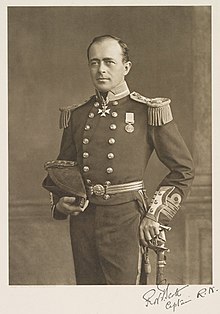Robert Falcon Scott | |
|---|---|
 Robert Falcon Scott in 1905 | |
| Born | 6 June 1868 Plymouth, Devon, England |
| Died | c. 29 March 1912 (aged 43) Ross Ice Shelf, Antarctica |
| Allegiance | United Kingdom |
| Branch | Royal Navy |
| Years of service | 1881–1912 |
| Rank | Captain |
| Expeditions | |
| Awards |
|
| Spouse(s) | |
| Children | Sir Peter Scott |
| Relations | Ettie Ellison-Macartney (sister) |
| Signature | |
Captain Robert Falcon Scott CVO (6 June 1868 – c. 29 March 1912) was a British Royal Navy officer and explorer who led two expeditions to the Antarctic regions: the Discovery expedition of 1901–04 and the Terra Nova expedition of 1910–13.
On the first expedition, he set a new southern record by marching to latitude 82°S and discovered the Antarctic Plateau, on which the South Pole is located. On the second venture, Scott led a party of five which reached the South Pole on 17 January 1912, less than five weeks after Amundsen's South Pole expedition. On the return journey from the Pole, a planned meeting with supporting dog teams from the base camp failed, despite Scott's written instructions, and at a distance of 162 miles (261 km) from their base camp at Hut Point and approximately 12.5 miles (20.1 km) from the next depot, Scott and his companions died. When Scott and his party's bodies were discovered, they had in their possession the first Antarctic fossils discovered.[1] The fossils were determined to be from the Glossopteris tree and proved that Antarctica was once forested and joined to other continents.[2]
Before his appointment to lead the Discovery expedition, Scott had a career as a Royal Navy officer. In 1899, he had a chance encounter with Sir Clements Markham, the president of the Royal Geographical Society, and learned of a planned Antarctic expedition, which he soon volunteered to lead.[3] His name became inseparably associated with the Antarctic, the field of work to which he remained committed during the final 12 years of his life.
Following the news of his death, Scott became a celebrated hero, a status reflected by memorials erected across the UK. However, in the last decades of the 20th century, questions were raised about his competence and character. Commentators in the 21st century have regarded Scott more positively after assessing the temperature drop below −40 °C (−40 °F) in March 1912, and after re-discovering Scott's written orders of October 1911, in which he had instructed the dog teams to meet and assist him on the return trip.[4]
- ^ "Antarctic Fossils | Expeditions". expeditions.fieldmuseum.org. Retrieved 8 January 2019.
- ^ "Four things Captain Scott found in Antarctica". BBC. Retrieved 11 October 2014.
- ^ Crane 2005, p. 82.
- ^ May 2013.